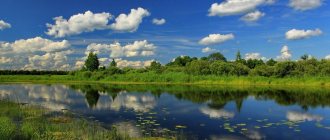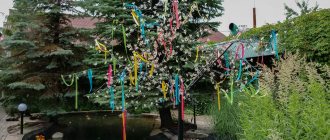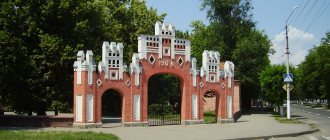What is a spring
Springs are small streams that emerge from the depths of the earth. On their way to the surface, they pass through different layers of soil, and are considered unique bodies of water, although in fact there is nothing special about them. They emerge from the same horizons into which home wells go deep. Each spring has a different taste and chemical composition.
Small trickles of groundwater are one of the main sources of recharge for large surface bodies of water: lakes, ponds and rivers, and are an important part of the water balance in the environment. Their cradle is deep underground, in aquifers that are rarely polluted. Using the examination of spring water, it is possible to accurately determine the degree of contamination of underground horizons caused by the industrial and agricultural development of the region.
Nowadays, it is considered normal to increase the maximum permissible concentrations of nitrates, nitrites and pesticides during the period of spring snowmelt, when a huge amount of dirty water seeps from the fields. Closer to summer, the condition of the spring will normalize
Depending on the nature of the supply horizon: pressure or non-pressure, water comes out in two ways:
- A spring is a gravity stream that freely descends to the nearest surface body of water or goes underground again;
- The key is that the water comes out under pressure, sometimes as a low fountain.
In resort areas, waters with a specific chemical composition come to the surface, which is why they are called mineral springs. They are used as a treatment for various diseases. The opinion that all spring water has a miraculous effect on the body is half invented. Only an increased content of chemical compounds in the soil, and their natural transfer into underground water carriers, can help normalize the functioning of the cardiovascular system, cleanse the body of toxins and alleviate the course of chronic diseases.
In settlements with a favorable environmental situation, natural springs are actively used by local residents, summer residents and travelers who would not mind refreshing themselves with cool water. There is just one caveat for non-locals - an organism unaccustomed to the chemical composition can react violently with food poisoning and digestive system disorders. Sanitary services are not able to systematically check all active springs. But due to massive environmental pollution, they only allow the consumption of raw water from a few sources.
Economy
- factory named after P. Kaminsky
- dairy
- chemical plant
- bakery
- garment factory
- "Rodniki-Textiles"
There is a 350 m high radio mast in the city.
The Rodnikovsky melange plant "Bolshevik" bore this name until 1989. In 1989, after the liquidation of industry ministries, the plant began to be called the State Rodnikovsky Cotton Production Association (GRPCBO), and since 1993 - OJSC "Rodniki - Textile".
Abandoned shelter of Zaitsev's relatives
One of the few who fight to preserve the historical value of cities are, perhaps, enthusiasts - history buffs. Among them is Teikovsky resident Igor Cheryomushkin, who at one time was the creator and director of the local local history museum, which, unfortunately, ceased to exist.
As Igor Yulianovich says, in the historical part of the city there is a house of the Shmannikovs, who once belonged to the city intelligentsia. This is a small wooden two-story house built in the Art Nouveau style before the revolution. In Soviet times there were apartments here, but recently the residents were resettled and the house is in an abandoned state.
“The Shmannikovs are relatives of fashion designer Vyacheslav Zaitsev,” says Igor Cheryomushkin. — One of the successors of the family, Dmitry Shmannikov, who now works in the city administration, is the fourth generation nephew of the famous fashion designer. So why not organize a Vyacheslav Zaitsev museum here, which would be dedicated to family values? There is no such museum in the region yet. At one time, we met with Vyacheslav Mikhailovich and talked about this topic. He is not against it, but he is waiting for movements from the authorities...”
Legal aspects of using springs
From the point of view of the law, a natural spring is a body of water. Ownership and other rights are described in detail in several articles. According to them, an individual or legal entity can own and manage only isolated reservoirs of artificial origin with a standardized area.
They must be non-flowing and not communicate with any surface water bodies. Simply put, if you dug a pond on your property and filled it from a tap, borehole or well, it is completely yours, and all other objects are the property of the Russian Federation or its constituent entities.
You cannot take possession of the spring, but it can be taken on a short-term or long-term lease if its purposes do not adversely affect the environment and are consistent with the power of the source.
Theoretically, a non-separated public spring can only be rented, for example, for the production of drinking water. Although the authorities should not agree to such agreements due to the fact that ordinary users will lose the opportunity to use water.
A would-be suicide was showered with gold coins
Another now abandoned house in the classicist style was built in the mid-19th century by the great-grandfather of Nikolai Nagorsky, who was the rector of the local Transfiguration Cathedral. It is noteworthy that he himself drew a drawing of the house and created its layout with his own hands. Local residents say that it is hardly possible to restore the building: everything inside is torn apart, there is no heating, no windows...
The building has a huge history. At first the Nagorsky family lived here. In 1914-1915, the city government was located, after the revolution - a library. Subsequently, the house was rented out as apartments, there was a society for the deaf, a club, clubs, and, in the 1990s, a store. At the moment, the building belongs to a private owner, but he apparently has no intention of restoring it or using it in any way: next to it there is again a “For Sale” banner.
Many legends are associated with this Nagorsky house in Kineshma, made in the style of classicism.
According to the staff of the Kineshma Museum, interesting legends are associated with this house. “One of the Nagorskys was an avid gambler,” says Natalya Shepeleva. “Somehow I lost to smithereens and, unable to pay off my gambling debt, decided to hang myself. He tied a rope with a loop to the hook of the chandelier, placed a stool under his feet... The stool fell apart, and a representative of the Nagorsky family hung on the rope. Suddenly, the stucco on the ceiling fell off along with the hook and gold coins rained down on top of the person... Life was saved.”
Another legend is associated with a ghost. Once upon a time, in the courtyard of this house there was a carriage workshop of the Chayanovs (the family of a revolutionary repressed during Soviet times). One day, a son and his father stole a slab from a local cemetery on a mountain to prop up the corner of a house.
In the morning it turned out that this was the tombstone of the mother of the famous admiral, explorer of the Far East Gennady Nevelsky - Feodosia Timofeevna. Father and son were unable to drag the tombstone back up the mountain, so they threw the slab nearby. Since then, local residents began to say that something always happens to a person passing by the house. Allegedly, it is Feodosya Timofeevna, who at one time was a woman with a tough character, who is taking revenge: she will either trip him up or push her.
Water supply from a spring
In addition to the standard water intake directly into containers from a source with a sufficient flow rate, it is possible to organize water supply for the entire site. Of course, you will have to work on clearing and arranging the territory, but it will be worth it. The idea of a spring water supply is especially relevant for temporary water supply until a well or borehole is dug and water is already needed.
Pure spring water does not require additional treatment with filters and water treatment systems that change its natural structure and chemical composition.
The disadvantage of a spring as a point of main water intake for household needs is its low return. On average, a trickle fills a 5-liter jar in a couple of minutes, but there are keys with a weaker output. It is clear that it will not be possible to directly power private water supplies from them. For such cases, a method for capturing springs has been developed. Near the source, a capture chamber is dug and lined, which will accumulate a reserve of water, and from it the supply to the water intake points is organized.
The presence of springs and rivers in the vicinity of the estate is a sure sign of the promising location of aquifers in the ground. It is considered especially lucky if, when digging a home well, it was possible to open underground springs and fontanelles, then there will always be water in the well and with a good influx
The use of springs of public importance for personal farming is possible only if the rights of other residents of the locality in which the spring is located are not infringed. Alternatively, you can arrange for excess water to be supplied from the outlet point so that no one feels left out.
The disadvantage of such a structure is that the owner of the site will not be able to monitor and protect the spring around the clock, unlike a home well, to which access to unauthorized persons is prohibited.
How to properly collect and store spring water
Having seen and tasted something good, we definitely want to take at least a small part of it with us. The situation is the same with spring water - large queues with bottles and canisters line up at the most famous springs with a proven healing effect.
If the collected spring water at home begins to become cloudy, green, or a specific “smell” appears, this means that organic matter has begun to actively develop in it. Microscopic algae and colonies of microorganisms grow in a “living” environment
Plastic containers are the most unsuitable container for drinking water in general, even bottled water, and even more so for healing spring water. The best option is glass containers that do not react with water when exposed to sunlight or elevated temperatures.
Typically, the outlet of a spring is formed by a pipe or groove through which water flows. You need to fill the container directly from it, and not scoop it up from a pool in the ground.
Spring water is not a product that you can stock up on for future use. The maximum storage period is 3-4 days. Then natural chemical and organic processes begin, which worsen its organoleptic characteristics and make it unsuitable for consumption. Due to colloidal impurities, water can form sediment on the walls of the dishes. You should not collect water if a dark coating is visible at the bottom of the spring reservoir.









